We discover some of the luxury fashion houses who are planning for a more sustainable, happier future.

The Fashion Pact
In 2019, a number of global luxury brands came together to create The Fashion Pact. Launched as a mission given to Kering Chairman and CEO, François-Henri Pinault by French President, Emmanuel Macron, the Fashion Pact was presented to Heads of State at the G7 Summit in Biarritz. By joining this global coalition, the companies highlighted their commitment to working towards combating key environmental issues including stopping global warming, restoring biodiversity and protecting the oceans. We discover some of the developments some of the brands have made to the cause since signing the pact last year.
The Prada Group

The Prada Group’s commitment to a more sustainable future has always been deeply rooted within the company’s strategy but it is something that has become even more at the forefront of the business in recent years. The Group’s principles are outlined in the Sustainability Policy which represents a formal commitment towards the communities in which it operates. This can be through investment in culture, integrating with local communities, inclusivity in the working environment and investment in more sustainable materials and practices.
Most recently, Prada has expanded the reach of its ground-breaking Re-Nylon collection. Using the latest in fabric and sustainable technology Prada’s Re-Nylon is a textile crafted from regenerated nylon created through a process of recycling and purification of plastic collected from the oceans, fishing nets, landfills and textile fabric waste. Through a method of de-polymerisation, purification and then transformation into new polymers and then threads, this material can be recuperated and made into new nylon fabric. The choice of the ECONYL® yarn for the Prada Re-Nylon collection actively contributes to the reduction of global warming by up to 90% compared to the use of the virgin nylon yarn. Prada aims to convert all of its virgin nylon into regenerated nylon by the end of 2021. The collection of ready-to-wear and accessories is available now in Prada stores.
Chanel
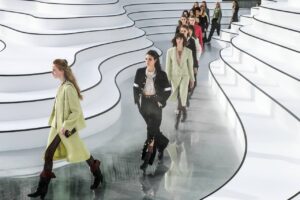
In March 2020 Chanel outlined an ambitious sustainability plan. Entitled Chanel Mission 1.5°, the plan was written in accordance with the 2015 Paris Climate Agreement, which aims to reduce the mean global temperature increase to 1.5°C. Chanel pledged to reduce emissions across the House’s operations by 50 per cent by 2030 and to reduce supply chain emissions by 40 per cent per unit sold, by the same year. It will move to 100 per cent renewable electricity by 2025 and balance residual carbon emissions by investing in nature-based research and solutions.
Burberry

Earlier this year Burberry launched ReBurberry Edit, a collection of products made from innovative materials that bring together the latest in sustainable material science. The collection of 26 styles which first debuted in the Spring/Summer 20 collection. Burberry’s responsibility highlights the brand’s longstanding commitment to sustainability and its dedication to reducing its environmental footprint and enabling social progress. By 2022 Burberry aims to source 100 per cent of its cotton sustainably, as well as have 100 per cent of its products with more than one positive attribute in terms of its social and/or environmental impact. This will be achieved either at raw material sourcing or at the product manufacturing stage. The brand also aims to source 100 per cent of its leather from tanneries with environmental traceability and social compliance certifications by 2022. The brand has also pledged to have 100 per cent renewable electricity by 2022 and aims to drastically reduce waste which began with its pledge to not destroy any unsaleable finished products.
PVH Corp.
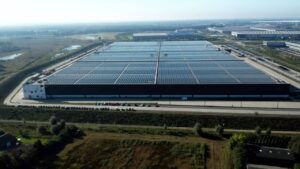
PVH Corp. whose brand portfolio includes Calvin Klein and Tommy Hilfiger recently embarked on the latest step on its journey towards a sustainable future. Its global headquarters in The Netherlands has unveiled the world’s most powerful solar roof. The roof will allow 100 per cent of the company’s electricity to be produced through renewable sources by 2030. The 48,000 solar panels that cover the roof covers the Centre’s electricity footprint, as well as indirectly providing 100% of all energy for PVH Europe’s warehouses, offices and stores in the Netherlands via the Dutch public power network. PVH Europe’s energy partner, Eneco, has certified that all energy needed to power these buildings is generated by the new rooftop installation. This work is linked to PVH’s science-based emissions target aligned with the most ambitious level of decarbonization as set out by the Paris Agreement. It is also one of the priorities outlined in the company’s Forward Fashion corporate responsibility strategy, which aims to reduce negative impacts to zero, increase positive impacts to 100% and improve the over 1 million lives across the company’s value chain.
Capri Holdings
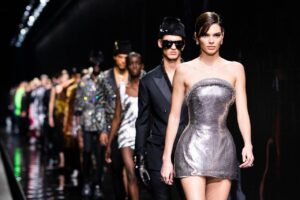
Capri Holdings which has Michael Kors, Versace and Jimmy Choo under its umbrella has stepped up its progress for the future in recent years. The group’s Corporate Social Responsibility Strategy encompasses significant and measurable goals across a range of environmental and social sustainability issues. The goals are split into three categories. “Our World” focuses on actions across the operations and supply chain to significantly reduce the environmental impact of the group’s brands. “Our Community” is a commitment to fostering a supportive, healthy, diverse and inclusive workplace for all employees. And “Our Philanthropy” is about connecting the talents, energy and success of the group’s brands to those in need around the world.
One clear example of the latter is Michael Kors’ Watch Hunger Stop collection which continues to work alongside the United Nations World Food Programme which works to reduce those lacking food around the world. The latest colourful campaign entitled Food Is Love – Share Your Heart stars some of the brand’s own employees. This year’s capsule was designed and produced with the aim of minimising environmental impact. 100 per cent of the proceeds will be going to the World Food Programme.
Salvatore Ferragamo
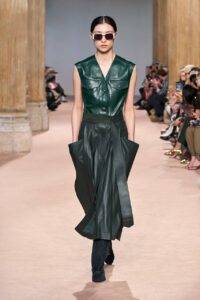
Since 2014 Salvatore Ferragamo has laid out a Corporate Sustainability Report in accordance with the international guidelines of the Global Reporting Initiative GRI – G4. To be transparent about its operations, the Company has committed to reporting on its corporate social responsibility initiatives. On a consumer level, Salvatore Ferragamo has developed new ways to provide sustainable alternatives for its customers. In December 2018, the Salvatore Ferragamo Group took part in the “Make Fashion Circular” initiative. This promotes the development of business models based on collaboration, the extension of the life of products, the reuse of energy and utilisation of renewable resources. Salvatore Ferragamo believes in the value of “Made in Italy” and seeks to create sustainable value for generations by continuing to keep all of its production and craftsmanship in Italy. By preserving traditional crafts and not outsourcing production, the brand helps to sustain jobs as well as cutting down on its carbon footprint. CEO, Mrs Micaela le Divelec Lemmi said:“In the past few years, recycled and regenerated nylon, wool, and silk have been selected to be increasingly used in our Collections, building on our Founder’s passion for innovative materials and relentless experimentation. We are thrilled to share our vision and environmental goals with industry leaders and to take collective actions on such crucial changes.”
In 2018, Salvatore Ferragamo presented its first shoe bound by the principles of sustainability. The Rainbow Future shoe was inspired by the iconic Rainbow sandal of 1938 and was presented in a limited edition of 100 pairs. The shoe was hand-finished and made from wood and organic crochet cotton. The leather lining was created with no carbon dioxide or water consumption. Rainbow Future obtained the ISO 14067 certification, whereby it is now possible to calculate the emissions due to its making and compensate them through reforestation programs, making it a “carbon neutral” shoe. Subsequently, the brand partnered with Treedom who planted 100 orange trees in the countryside on the outskirts of Catania (Sicily), within the sustainable production of high-quality products through environment-friendly processes. A code written on the accompanying certificate will inseparably link each tree to a pair of Rainbow Future – a precious symbolic gift from Salvatore Ferragamo to the clients who purchase the shoe.
Hermès
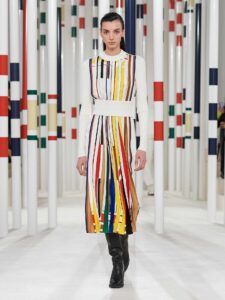
As a brand, Hermès has always worked towards sustainable development. The House prides itself on preserving traditional crafts and these values have been passed down through the generations. The brand’s quest for authenticity, responsibility and respect for nature have allowed sustainability to come naturally to the House. Hermès seeks out the most beautiful materials offered by nature for its collections. Their artisans’ skilful hands respect leather, silk, fabric, wood, crystal and precious metals. They see it as their duty to achieve the sustainable use of these resources. Hermès seeks to source where possible, its workforce in France and commits to promoting local employment and preserving traditional crafts. Furthermore, as part of the energy transition launched by the Paris Agreement, Hermès integrates renewable energies into its electricity consumption in France as well as supporting the WWF to protect against endangered species in the Congo Basin. The brand also partners with several non-profit organisations around the globe, helping to preserve our planet and provide a better environment for future generations.
Gucci
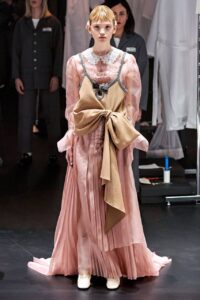
In 2017, Gucci outlined a ten-year Culture of Purpose sustainability plan. “Gucci is committed to a culture of purpose putting environmental and social impact at the heart of the brand,” says Marco Bizzarri, Gucci President and CEO. The plan outlines key guidelines that will form the future of the House including reducing the environmental impact of its business operations with a special focus on the use of energy and water, waste production, hazardous chemicals and the sustainability of raw materials; identifying and assessing both direct and indirect social and economic environmental impact along the entire supply chain and promoting within its spheres of influence actions for the improvement and development of support for people and their environment. The company is committed to reducing its environmental impacts and is setting ambitious targets to create a new standard in luxury retail, guaranteeing the traceability of 95% of their raw materials. In 2019, Gucci announced that they will pay every year to offset the emissions it can’t eliminate from its supply chain to become carbon neutral. In 2018 the brand presented its first fur-free collection beginning with Spring/Summer 2018. The company continues to search for sustainable alternatives, finding the least invasive processes, dreaming up innovative solutions and looking after the people who help them achieve what is part of the Gucci House.















